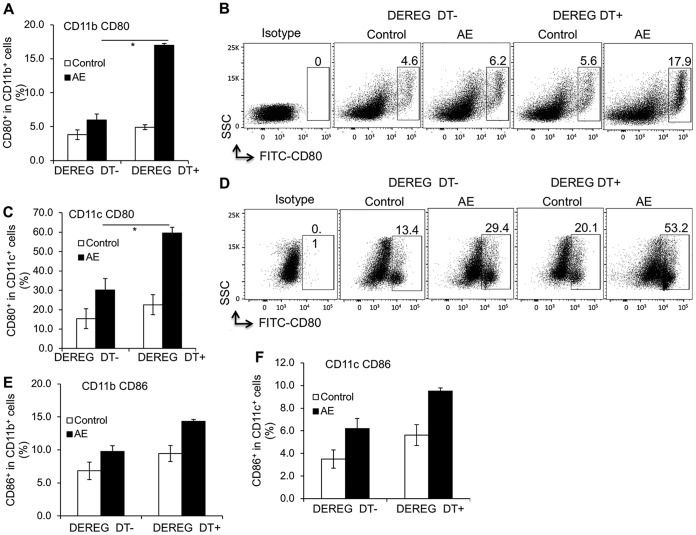FIG 7.
Foxp3+ Treg-inducible knockdown against primary AE and its related APC activation (assessed by FACS). (A) CD80 frequency within CD11b+ APCs in spleen cells from AE-DEREG DT− and AE-DEREG DT+ mice at 3 months postinfection. (B) Representative scatter plots of CD80+ cells within CD11b+ APCs in spleen cells from AE-DEREG DT− and AE-DEREG DT+ mice at 3 months postinfection. (C) CD80 frequency within CD11c+ APCs in spleen cells from AE-DEREG DT− and AE-DEREG DT+ mice at 3 months postinfection. (D) Representative scatter plots of CD80+ cells within CD11c+ APCs in spleen cells from AE-DEREG DT− and AE-DEREG DT+ mice at 3 months postinfection. (E) CD86 frequency within CD11b+ APCs in spleen cells from AE-DEREG DT− and AE-DEREG DT+ mice at 3 months postinfection. (F) CD86 frequency within CD11c+ APCs in spleen cells from AE-DEREG DT− and AE-DEREG DT+ mice at 3 months postinfection. Data represent means ± SD for a total of 6 mice in noninfected control groups and 5 mice in the AE groups (AE-DEREG DT− and AE-DEREG DT+) after excluding mice developing subcutaneous lesions or presenting no lesion at all. Comparison between groups was performed using a two-way ANOVA with Bonferroni's multiple-comparison posttest for statistical analysis. *, P < 0.05. DEREG DT−, foxp3-inducible knockdown mice (DEREG mice) without DT application; DEREG DT+, DEREG mice with DT application; AE-DEREG DT−, E. multilocularis-infected DEREG without DT application; AE-DEREG DT+, E. multilocularis-infected DEREG mice with DT application. Control, noninfected mice. DT application started 1 month postinfection and was maintained for 1 month, and mice were sacrificed at 3 months postinfection.

